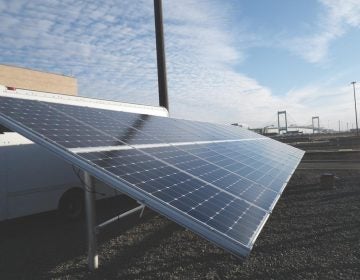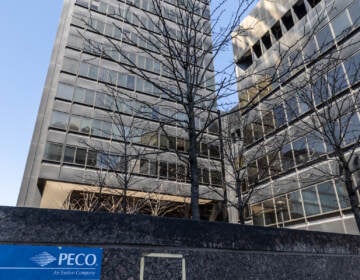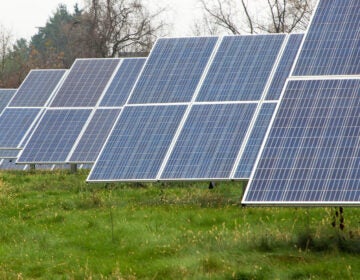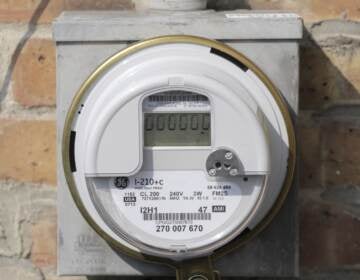After years of delays, Adams Solar Farm powers a quarter of Philly’s city buildings
A month after the Adams Solar Farm went online, Philly is seeking more renewable electricity to power the rest of its municipal buildings.
Listen 1:07
An aerial view of the 80 MW solar field in Adams County. About 230,000 panels will help power city-owned buildings, allowing Philadelphia to move closer to its climate goal of 100% renewable energy by 2030. (City of Philadelphia)
Have a question about Philly’s neighborhoods or the systems that shape them? PlanPhilly reporters want to hear from you! Ask us a question or send us a story idea you think we should cover.
Roughly a quarter of the electricity running Philadelphia’s municipal buildings now comes from solar power.
The Adams Solar Farm — a 230,000-panel solar array near Gettysburg — started generating energy in late March. The city has committed to buying most of the farm’s power for the next 20 years.
“We’re demonstrating our commitment to combating climate change and building a more sustainable future for Philadelphians for generations to come,” Mayor Cherelle Parker said before flipping an 8-foot-tall light switch at a press event celebrating the completion of the solar farm Tuesday.
The 70 megawatts of power the city buys from the array for its municipal buildings is enough to power more than 17,000 rowhouses.
The project brings the city’s electricity use to 30% renewable — still short of the 100% target the city plans to meet within the next six years.
The city first signed an agreement for the power in 2018, but the project hit years of delays. NBC10 reported in 2022 that three different developers had failed to build the solar farm, and city officials blamed the pandemic. Energix Renewables now owns the project.
“Adams Solar has been a long time coming,” said Emily Schapira, president and CEO of the Philadelphia Energy Authority, which helped the city set up the long-term contract to buy the power. “Adams Solar is exactly the type of ambitious, cost-effective and environmentally beneficial projects the city must continue to pursue.”
The city’s 20-year contract means the price it pays for the renewable power will stay the same, even if gas-powered electricity rates go up. City officials say they expect this to save taxpayers money in the long-term.
A new request for proposals released Tuesday for more renewable electricity would power all municipal buildings with wind or solar by 2030. Officials plan to choose a contractor this fall.
The city has been working to reduce its energy use with energy efficiency upgrades in municipal buildings and replacement of street lights with more efficient LEDs. Philly’s other 2030 targets include cutting greenhouse gas emissions from city-owned buildings in half and reducing municipal energy use by 20%.
In Philadelphia, buildings and industry contribute the greatest share by sector of planet-warming carbon emissions.
Even if buildings use renewable electricity, they can still release carbon emissions if their appliances run on gas. A 2019 greenhouse gas emissions inventory found that natural gas was a bigger source of emissions than electricity in Philly’s residential buildings.
The city’s 2030 goal of all renewable electricity in municipal buildings does not require it to switch away from gas, but the city’s 2050 carbon neutrality goal likely would. The city owns the natural gas utility Philadelphia Gas Works, which recently received budgetary approval from the Gas Commission for $19 million in new natural gas infrastructure.
Dominic McGraw, deputy director of the city’s Municipal Energy Office, declined to specify Tuesday whether the city has a plan to get its buildings off of gas.
“We’re looking at all options right now to see how we can meet the 2050 goals,” McGraw said.
Statewide, solar still makes up just a tiny fraction of electricity produced in Pennsylvania. The leading sources of electricity generation remain natural gas, nuclear and coal.

Get daily updates from WHYY News!
WHYY is your source for fact-based, in-depth journalism and information. As a nonprofit organization, we rely on financial support from readers like you. Please give today.







